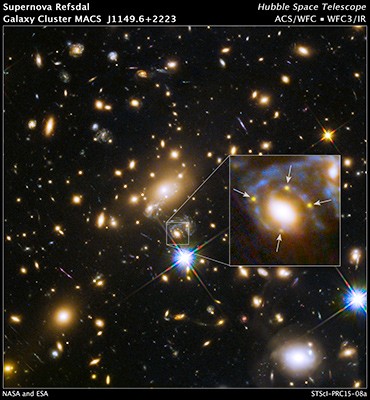9 Billion Year-Old Supernova Seems to Explode Four Times; will 'Explode' Again in 5 Years
| Ana Verayo | | Mar 06, 2015 04:36 AM EST |
(Photo : NASA, ESA, and S. Rodney (JHU) and the FrontierSN team; T. Treu (UCLA), P. Kelly (UC Berkeley), and the GLASS team; J. Lotz (STScI) and the Frontier Fields team; M. Postman (STScI) and the CLASH team; and Z. Levay (STScI)) The image shows the galaxy's location within a hefty cluster of galaxies called MACS J1149.6+2223, located more than 9 billion light-years away.
Using the Hubble Space Telescope and a natural cosmic magnifying lens, astronomers have seen amazing multiple images of the same exploding ancient star.
The four stunning images taken by Hubble were apparently caused by light following different paths around a colossal galaxy cluster located between the exploded, distant star and the space telescope orbiting the Earth.
Like Us on Facebook
The star system's gravity affects passing photons or particles of light and bends them, a pnenomenon foreseen by Albert Einstein some 100 years ago.
Astronomers use this unique phenomenon called gravitational lensing to boost Hubble's ability to take images of very distant objects and to take a look farther back in time.
In a rare coincidence, this supernova that exploded some nine billion years ago was also aligned with another galaxy cluster during a Hubble observation in 2011.
Scientists examined the images again in November to search for supernovae and discovered a quadruple rendering, a configuration known as an Einstein cross.
According to astronomer Jennifer Lotz from the Space Telescope Science Institute in Baltimore, the supernova team was just looking at these images and then four more other images popped up, and they were incredibly lucky to witness this.
This object is named Supernova Refsdal after Norwegian astronomer Sjur Refsdal, who also first detected the multiple imaged supernova. Its appearance is 20 times brighter than its natural brightness due to the combination of two overlapping lenses, according to Jens Hjorth from the Dark Cosmology Center, Denmark.
The light from this supernova will fade eventually when the explosion reduces but the additional warping from the light of the galaxy cluster can cause another occurrence of the explosion.
According to Steve Rodney from the Johns Hopkins University, these four supernova images were captured by Hubble and appeared during a few weeks of each other.
The supernova may have already appeared in a single image somewhere in the cluster field 20 years ago. It's now expected to reappear one more time in the next year or in five years. This study will be published in the journal, Science.
TagsHubble Space Telescope, Supernova, einstein's cross, gravitational lensing, explode supernova astronomers reruns quadruple image star einstein cross, 9 Billion Year Old Supernova Explodes Four Times; Will Explode Again in 5 Years
©2015 Chinatopix All rights reserved. Do not reproduce without permission
EDITOR'S PICKS
-

Did the Trump administration just announce plans for a trade war with ‘hostile’ China and Russia?
-

US Senate passes Taiwan travel bill slammed by China
-

As Yan Sihong’s family grieves, here are other Chinese students who went missing abroad. Some have never been found
-

Beijing blasts Western critics who ‘smear China’ with the term sharp power
-

China Envoy Seeks to Defuse Tensions With U.S. as a Trade War Brews
-

Singapore's Deputy PM Provides Bitcoin Vote of Confidence Amid China's Blanket Bans
-

China warns investors over risks in overseas virtual currency trading
-

Chinese government most trustworthy: survey
-

Kashima Antlers On Course For Back-To-Back Titles
MOST POPULAR
LATEST NEWS
Zhou Yongkang: China's Former Security Chief Sentenced to Life in Prison

China's former Chief of the Ministry of Public Security, Zhou Yongkang, has been given a life sentence after he was found guilty of abusing his office, bribery and deliberately ... Full Article
TRENDING STORY

China Pork Prices Expected to Stabilize As The Supplies Recover

Elephone P9000 Smartphone is now on Sale on Amazon India

There's a Big Chance Cliffhangers Won't Still Be Resolved When Grey's Anatomy Season 13 Returns

Supreme Court Ruled on Samsung vs Apple Dispute for Patent Infringement

Microsoft Surface Pro 5 Rumors and Release Date: What is the Latest?










